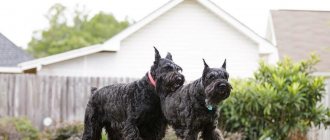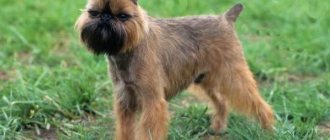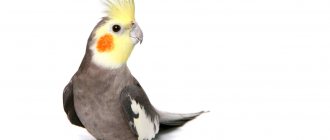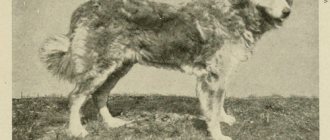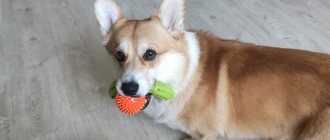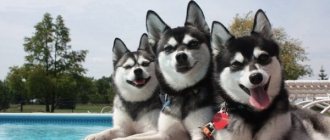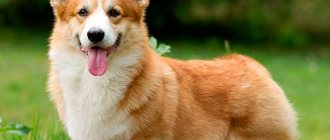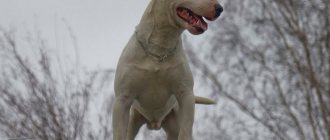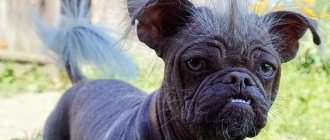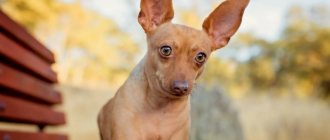Giant Schnauzers are large and very hardy dogs with a large, heavy head, adorned with a beard, eyebrows and mustache. Thanks to its excellent watchdog qualities and balanced psyche, the breed is popular not only among intelligence officers, but also among ordinary owners.
Let's figure out what is hidden behind the external brutality of Giant Schnauzers and what are the specifics of their content.
Breed characteristics
| Short description | |
| Origin: | Germany |
| Conditions of detention: | In an apartment, insulated enclosure all year round |
| Purpose: | Watchdog, companion |
| Color: | Black, “pepper-salt” |
| Wool length: | Medium, has a characteristic beard and eyebrows; double (thick, hard undercoat and dense guard hair) |
| Adult dog size: | Height – from 60 to 70 cm (at the withers). Weight – from 35 to 47 kg. |
| Average life expectancy: | 11-12 years old |
| Walk: | 2 times a day, at least 3 hours daily |
| Physical activity needs: | Intense physical activity required; The ideal training option is to accompany the owner on a bike ride (or ski track in winter) |
| Fédération Cynologique Internationale (FIC) classification: | Group 2; Section 1 “Pinchers and Schnauzers” |
| Puppy price: | From 20 thousand rubles to 50 thousand rubles (show animals) |
How much does a miniature schnauzer cost?
The cost of a purebred miniature schnauzer puppy starts from 18,000 rubles.
In the documents of the parents of such a puppy, the rating for exterior is “very good” or “good”. As a rule, there are no champions among his immediate ancestors. Puppies from titled parents cost from 25,000 to 38,000 rubles, depending on the region of Russia.
It is worth remembering that kids who have even the most famous ancestors in their pedigree will not necessarily become championship winners and participants in breeding. But a healthy, cheerful purebred Miniature Schnauzer puppy, growing up in an atmosphere of love and attention, will give you joy every day, demonstrating all the advantages of this wonderful breed.
History of the origin of the species
There is no reliable data on the origin of Giant Schnauzers. Most researchers of the pedigree of this breed agree that the earliest information about “dogs with a beard” appears in Germany during the Middle Ages. For example, the sketches of the painter Albrecht Durer (late 15th century) contain images of dogs of a similar type.
The place where these dogs appeared is considered to be two German regions with the central cities of Stuttgart and Munich.
The ancestors of the breed were probably ordinary village dogs that helped people herd and protect herds. Over the course of several centuries, there was a natural mixture of different types of German Shepherd Dogs, as well as artificial crossing with Flemish Shepherds and Great Danes. As a result, this led to the formation of a large individual that has recognizable external characteristics.
By the beginning of the 20th century, the main characteristics of the dog’s exterior had been formed, and the standard of the Giant Schnauzer was approved.
Video
* We invite you to watch a video about the Giant Schnauzer . In fact, in front of you is a playlist in which you can select and watch any of 20 videos about a given dog breed by simply clicking on the button in the upper right corner of the window. In addition, the material contains quite a lot of photos. By looking at them you can find out what a Giant Schnauzer looks like.
In this article:
|
Distinctive features
The Zenschnauzer was recognized by the FCI in 1955, classified in Group 2, Section 1 “Pinchers and Schnauzers” and has the following distinctive features:
- The head is large, heavy, powerful, somewhat elongated; gently tapers towards the nose; Shape: triangle with equal sides.
- The ears are set high, triangular in shape, cropped.
- The eyes are oval-shaped, set straight; color dark brown.
- The stop is clearly defined, noticeably outlined by thick eyebrows.
- The muzzle is wedge-shaped, slightly smoothed, with a characteristic beard.
- The jaws are powerful; cheekbones are well developed.
- The nose is noticeable, large, black, protruding.
- The lips are black (with coats of both colors).
- The teeth are massive, white, a full set of 42, the fangs are clearly defined; bite .
- The physique is proportional, square.
- The muscles are sculpted.
- The neck is massive, proportional to the body, set at an angle of 45°, no wrinkles.
- The croup is strong, lean (dry constitution), strong.
- The chest is oval-shaped, of medium width.
- The stomach is tucked.
- The line of the back is sloping; loin is short.
- The limbs are straight, the hind legs are slightly shorter than the front ones.
- The movements are energetic, light, stable.
- The coat is of medium length, there is a characteristic beard and eyebrows; double (thick, hard undercoat and dense guard hair); color black, “pepper-salt” (undercoat gray or silver).
- The tail is short, set high, docked at the level of 2 or 3 vertebrae.
Popular colors of Giant Schnauzers
Two colors are recognized as standard for the breed:
- Completely black;
- Pepper and salt.
They are regulated, details such as shades, depth, halftones, and so on are clearly established. At the same time, with the first color, everything is relatively simple: the coat and undercoat should be black. Experts evaluate the depth of color and the absence of tan, “rusty” undercoat, spotting, and the like.
If none of these are present, the dog meets the standards. Over time, gray hair appears - its suitability for the age of the animal is also assessed. Black color is quite easy to evaluate; salt and pepper is a completely different matter. Gray Giant Schnauzers are very difficult to evaluate; many articles are devoted to this problem.
At first, it may seem that such dogs are simply ash-gray, and the inclusions of white in the coat are evenly distributed, and there are no other peculiarities in the color. But this is not so: with visible chaos, dark and white hairs are located in certain zones, which must be at the correct distance from each other.
This is what allows you to get the effect of uniform color, pleasing to the eye. There are also frequent deviations in which light and dark spots on the coat are easily distinguishable. There should not be such spots, and in addition to uniformity, there are other requirements for color: the ash tone should be intense, and the undercoat should be light pepper, with a soft accent.
Variations of color are possible, from dark steel to light silver, all of them are recognized as the standard. Giant Schnauzers should always have a dark mask on their face.
Photo of an adult dog
Photos of puppies
Features of character and behavior
The Giant Schnauzer is an excellent example of a guard dog with phenomenal working characteristics . Character – calm, self-possessed, flexible. The dog combines obedience, patience and high mobility. Together with intelligence and an exceptional ability to learn commands, these qualities make the Giant Schnauzer an ideal protector and reliable companion. The breed is classified as a service breed, which means that Giant Schnauzers do an excellent job of protecting and guarding both humans and the entrusted territory.
Given the extraordinary abilities and extraordinary need for activity, it is not recommended for inexperienced owners to own a dog. Lack of breed-appropriate training and exercise can lead to obedience problems .
Advantages
The Giant Schnauzer has numerous advantages:
- Has high intelligence scores, is inquisitive, and self-confident.
- Endowed with uniquely high performance and endurance.
- Excellently trainable, active, capable of quickly learning commands.
- It is one of the best among guard dogs, since along with protective qualities it has a balanced temperament.
- Does not react to extraneous sounds and movements by barking for no reason.
- He makes contact easily, but is cautious with strangers, especially when performing guard duties.
- He is attentive to the owner’s “mood” and adapts to his condition.
- Always ready to accompany the owner; during walks he vigilantly watches those around him, but does not show aggression.
- Suitable for families with children, with whom he shows unlimited patience and friendliness.
- Gets along well with other pets.
- Does not have a typical dog odor.
Flaws
The disadvantages usually include the following:
- The need for daily long-term (many hours) exercises, including both physical activity and practicing various commands; in the absence of appropriate exercises, the Giant Schnauzer turns into a sad, unhappy creature;
- Not suitable for keeping in a small apartment or studio;
- Not suitable for inexperienced owners, as well as people with a soft and calm character; The Giant Schnauzer requires firmness in education and active participation of the owner;
- Given its size, it is not recommended for older people to have a pet of this breed;
- Grooming requires significant financial investments, as well as time (visiting a professional groomer).
A dog is absolutely not suitable for people who do not have the opportunity to devote a sufficient amount of time and effort to training their pet and who lead a sedentary lifestyle.
Training
A bossy dog always wants to dominate, so the owner must have training experience or turn to professionals. To avoid raising a monster, you will need to take parenting seriously. Socialization will be required during puppyhood.
The animal is capable of performing both basic and complex commands, but due to its natural stubbornness and internal resistance, it will require patience and consistency of demands.
A hot-tempered nature needs to extinguish aggressiveness in childhood. It is not difficult to entice dogs; a game form that ends with reward is suitable for this. Before the lesson, take a walk to release energy, concentration and satiety will interfere.
When ignoring orders, do not indulge in these tricks, otherwise leadership will end. The trick is expressed in testing the owner's strength. The pet can play around as if he doesn’t hear, always get your way, otherwise you will pay with loss of respect.
Additional training is provided for individuals participating in shows; they are required to tolerate the touch of strangers and not growl. They are also working on the exhibition stand.
Care and maintenance
A Giant Schnauzer can live with equal success both in an apartment and in an enclosure on the site of a country house. The exception is small-sized apartments and studios, where organizing enough space is often difficult. Keeping them outside is only possible in an insulated enclosure with additional heating in winter. The enclosure or booth must be installed on a wooden foundation (raised 20 cm from the surface), under a canopy and in a
dry place.
The last option for placing a Giant Schnauzer should be used as a last resort, since short hair cannot save the dog from severe frost.
In addition, placing the dog outside does not allow for close contact between the dog and the owner. And this is an indispensable condition for the formation of a calm and balanced character of the Giant Schnauzer.
Keeping a Giant Schnauzer on a leash is not allowed.
- bathed as needed. Usually 1-2 times a year is enough for the pet to have a well-groomed and tidy appearance. Only the face of the Giant Schnauzer requires special attention. It must be wiped after each feeding.
- eyes require weekly examination for discharge. But even in their absence, it is recommended to visit a specialized doctor once every 6 months. Giant Schnauzers are susceptible to various ophthalmological diseases.
- The ears also require inspection once a week. In addition to dust and dirt, it is necessary to remove excess hair from the ears that covers the ear canal.
- claws are trimmed as they grow. Often, due to prolonged loads, they wear down without intervention from the owner.
Nutrition
It is recommended that the Giant Schnauzer's diet be based on natural products. This is meat, cottage cheese, kefir, cereals and vegetables . High activity and high weight, which an adult dog must achieve, require protein food almost from birth.
The puppy's feeding regimen is subject to the following basic requirements:
- The portion should be appropriate for the puppy’s age; This can be determined by behavior - if the baby eats the amount and peacefully goes to his place, without requiring supplements, the amount is selected correctly;
- There are no night feedings in the nutrition plan;
- During the daytime, it is recommended to give food at certain hours; the first appointment is usually no later than 7 am, the last appointment is no later than 21-22 o’clock;
- Cottage cheese and porridge are given in the first half of the day; meat and vegetables - in evening feedings.
We recommend that you read a detailed article on the topic: “How and what to feed a dog: types and characteristics of nutrition.”
The number of feedings depends on the age of the pet:
- 1-3 months – 5-6 feedings; volume 200-300g;
- 3-6 months – 4 feedings; volume 700-800g;
- 6-12 months – 3 feedings; volume 1-1.2 l.
Upon reaching the age of 1 year, the dog is considered an adult and is transferred to 2 meals a day. The diet should consist of meat, kefir and vegetables. The order of submission remains the same. Morning feeding consists of dairy food; In the evening, meat and vegetables are given.
With a natural diet, the pet additionally needs to take vitamins. Typically, such courses are prescribed 1-2 times a year. The dosage and name of the complex are selected individually.
Dry food is recommended for use in the diet of older Giant Schnauzers. Starting from 7-8 years old, they require increased amounts of vitamins and minerals.
Premium+ dry food usually contains the necessary additives in the right ratio.
You can use ROYAL CANIN, EUKANUBA, PROPLAN (PURINA), BOSCH, HILL`S, HOLISTIC. The feeding volume is indicated by the manufacturer on the packaging. The dosage should not be exceeded.
Regardless of the type of food, your pet should always have fresh water available.
Health
Giant Schnauzers have excellent health . These are strong and hardy dogs, which are distinguished by strong immunity. The condition of the pet’s body usually does not cause concern for a long time, and special measures are not required to maintain health.
Good physical characteristics allow dogs to be independent of environmental conditions. The performance of the Giant Schnauzer is at a very high level; The returns from these dogs are amazing.
Life expectancy under proper loads can be up to 14 years.
Vaccinations
The vaccination schedule for Giant Schnauzer puppies does not differ from vaccination measures for puppies of other breeds. The first vaccine is given at 2 months, and again after 21 days. It is used as comprehensive protection against plague, parainfluenza, hepatitis and parvovirus enteritis.
At 6 months, a rabies vaccine and a third complex vaccine against major infectious diseases are given. If at this moment the dog has a change of teeth, vaccination is shifted to a later period.
Starting from 12 months, the animal is revaccinated annually.
Important article on the topic: “Everything you need to know about dog vaccinations.”
Diseases
In general, the health of the Giant Schnauzer does not require increased attention from the owner. Diseases to which representatives of this breed are susceptible are limited to diseases characteristic of large dogs:
- Hip dysplasia;
- Bloating (often due to poor diet and exercise habits);
- Atopic dermatitis;
- Diabetes (in old age).
In addition, Giant Schnauzers are susceptible to a number of ophthalmological diseases: retinal atrophy, glaucoma, cataracts.
Walk
Giant Schnauzers should be able to spend long periods of time each day in active activities.
Walking your pet must be organized at least 2 times a day, the duration of each walk is at least 1.5 hours.
Dogs are highly active and very mobile. Therefore, the walk should consist mainly of high-intensity physical activity. The best option for a Giant Schnauzer would be to accompany the owner on a bike ride.
To stimulate brain activity, the dog must be trained to train “intellectual” commands. Basically we are talking about search games in which the tasks “sniff”, “search”, “bring” are practiced.
Grooming
The absence of heavy shedding is an undoubted advantage of Giant Schnauzers . Short wool dries quickly, gets dirty a little, and does not tangle.
However, it would be wrong to think that pets' fur does not need care. On the contrary, dense guard hair and a thick and coarse undercoat require frequent combing - at least once a week. This can be done using a stiff bristle brush and a furminator, which easily removes dead hair. It is recommended to comb your beard and eyebrows at least 3-4 times a week using a simple single-row comb . Additionally, it is necessary to trim the hair around the pads.
In addition to regular care, the Giant Schnauzer's coat undergoes a special procedure at least 2 times a year. We are talking about trimming, which should be entrusted to a professional. This is especially important if the dog is planned to participate in exhibitions.
Dogs usually react with displeasure to manipulations associated with brushing, bathing and grooming. Giant Schnauzers are no exception. Therefore, it is necessary to accustom your pet to these procedures from the first days of life. To prevent your baby from being afraid of the table, bath or scissors, you can use treats to encourage calm behavior .
DIY trimming
If you have experience, you can carry out the trimming procedure yourself.
It is recommended to carry out the rolling procedure at home. It involves manually plucking mature hair from the dog's body. In this way, up to 20% of the fur is removed. This manipulation of the Giant Schnauzer's fur is carried out once every 2-3 weeks. For this, in addition to a brush and a furminator, you will need a clipper and scissors.
The machine is used to cut off excess hair on the neck, under the tail (on the butt).
The hair on the ears and head is first trimmed with ordinary scissors. A hygienic haircut is carried out in the groin and paws. To give it an exhibition look, use special thinning knives (or scissors). They allow you to create beautiful transitions of hair of different lengths.
Full trimming is carried out 2 times a year, during seasonal molting.
After hair removal, it is recommended to treat the Giant Schnauzer's skin with antiseptic preparations until new hair appears.
Giant Schnauzer haircut pattern
Preparing the exterior of a Giant Schnauzer for an exhibition consists of two stages.
2 months before the exhibition the following procedures are carried out:
- Plucking dead hair on the neck, body and hind legs (including the undercoat);
- Intensive combing with a furminator;
- Trimming excess hair on the throat, tail, butt, and groin area.
2 weeks before the exhibition, the remaining excess hair is plucked out and the haircut is carried out directly according to the following scheme:
- Longer hair from the lower half of the chest is shortened with thinning scissors towards the belly and groin, the transition should be as smooth as possible;
- The hair on the tail, around the anus and genitals is cut off completely;
- The hair on the thighs (outer side) is plucked to such an extent that the muscle relief is clearly expressed;
- The fur on the inner thighs is trimmed;
- Hair is not removed from the forelimbs (except for individual hairs sticking out);
- On the throat, six is cut extremely short, from a few millimeters in the lip area to longer in the upper part of the neck and shoulder blades;
- The hair on the ears is shortened (inside and outside), in the ear canal it is completely plucked;
- The hair on the forehead to the eyebrows, as well as on the cheekbones, is cut very short;
- From the hair on the eyebrows, a “bang” is created in the form of a triangle, up to the middle of the muzzle;
- The beard is combed downward, while the hair on the side of the jaws is smoothly shortened;
- After cutting all parts, the general appearance of the dog is assessed, and the transitions in those areas where hair of different lengths are formed are corrected.
Interesting Facts
Giant Schnauzers are interesting not only for their working qualities. Over the years of the breed’s existence, many interesting facts have been associated with it:
- At first, Rizens were called beer or bear schnauzers. The first name was assigned to the breed due to the fact that the dogs often guarded carts with beer. The second is due to the fact that dogs were involved in hunting bears.
- The modern name of the breed has German roots and consists of two words – riesen (giant) and schnauzer (muzzle).
- Giant Schnauzers appeared in the USSR only in the 1970s. The first purebred littermates Akbar and Anni f. Raakzee were brought to the leading nursery “Krasnaya Zvezda” and became the founders of the domestic line of the breed.
Mating
Breeding a Giant Schnauzer is associated with certain difficulties due to the small number of high-quality representatives of this breed.
To obtain offspring with a stable psyche, the following points must be taken into account when mating:
- Manufacturer's fame (pedigree), success at exhibitions;
- The character of the dog should be even, patient and obedient;
- Performance characteristics of the individual (checking is carried out at training sites).
Owners of bitches need to prepare a place for keeping puppies in advance. This breed has numerous litters, up to 12 pieces.
Otherwise, mating is subject to the basic rules and is carried out:
- At the age of no earlier than 18-24 months, in the interval from 11 to 14 days of estrus;
- In the morning;
- On empty stomach;
- In the dog's territory.
Read a detailed article on the topic: “Everything you need to know about breeding dogs: appropriate age, what to do if it doesn’t work out, rules and tips.”
Feeding
A quarter of the diet should be lean meat.
Protein foods also include sea fish, fermented milk products, and eggs.
From cereals - buckwheat, rice, oatmeal. Be sure to include stewed and fresh vegetables and fruits .
Young animals and puppies must be given vitamin and mineral supplements.
These can be either complex preparations or the well-known fish oil and bone meal.
Key points in training
Giant Schnauzers have excellent intelligence and quickly grasp what their owner or dog handler requires of them. Therefore, training these animals is a pleasure. They are patient, obedient, and rarely conflict.
In order to quickly establish contact with your pet, it is recommended to include an element of novelty in each activity, coming up with interesting search tasks for the Giant Schnauzer.
It is better to practice basic commands in the second part of the walk, after the dog has used up an extraordinary charge of energy.
Read about how to properly train a dog in the article: “Training a puppy: effective methods from dog handlers, learning commands at home.”
Breeding Giant Schnauzers
If you are the owner of a male dog, you should immediately decide whether you will breed him. For the dog himself whether they exist or not is not so important. If you walk your pet often and exercise it, then there will be no problems even if there are no matings. Therefore, the key factors here are: how much demand he has, whether he has success at exhibitions, whether his nervous system is stable, and the like.
It is more difficult for owners of bitches, because when puppies appear, they will face many new problems. There are often many puppies in a litter - up to 10-12, you need to take into account that all of them will need a lot of space, as well as funds for food and medications. Puppies will need to be kept for at least one and a half months, and some often stay for up to 3-4 months.
It will be much more difficult for beginners to place puppies than for experienced breeders with a reputation, especially if they choose owners and not give them away to just anyone. Puppies grow quickly and, if the adult Giant Schnauzers behave calmly in the house, the young ones play and frolic - and with each week their games become more and more destructive for the home.
On the other hand, this can also be an opportunity to earn money, but only if both parents meet all breed standards and the mating is registered - you won’t get much for puppies from an unregistered mating.
Bitches come into heat once, or more often twice, a year. You can tell about its imminent onset by the changed behavior of the pet: within a week or two there is a decrease in performance, absent-mindedness, and she marks her territory more often.
Mating is carried out twice with an interval of one and a half to two days. Pregnancy lasts two months or a little longer. Typically, with more puppies, the gestation period is shorter. The approach of childbirth is indicated by the dog's search for a secluded place for birth. It is better if the owner prepares it himself.
This should be a draft-free place, calm, warm and shaded. During the first birth, it is worth staying close to the dog in case of complications. If the process takes longer than an hour, and you have little experience, you need to call a veterinarian.
How to choose a puppy
Before you decide to choose a puppy of this particular breed, you need to carefully familiarize yourself with the features of caring for and keeping your pet. Giant Schnauzers are generally unpretentious, but making their coat look beautiful will require a lot of effort, time and money. It is also necessary to remember that these dogs are characterized by increased activity. Each walk should last at least 1.5 hours.
If the nuances do not bother you, when choosing a puppy, it is recommended to be guided by the following:
- Purchase only from trusted breeders;
- Conduct an assessment of behavior and physical characteristics - the puppy must be active, sociable, have a good appetite (weight at 2 months should be 5-6 kg);
- The color of the puppy is black or “pepper and salt” (the limbs have a light or grayish tint);
- The exterior must correspond to the approved parameters, including: hard, short hair, black claws, rectangular skull, flat back.
The Giant Schnauzer combines incredible strength and power, on the one hand, and goodwill and equanimity, on the other hand. It is the combination of these traits that makes them popular and desirable dogs.
4.7 / 5 ( 3 voices)
Health
This “big guy” is in good health. But there is still a hereditary predisposition to certain diseases:
- Cataract.
- Hypothyroidism.
- Hip dysplasia.
- Volvulus.
- Pancreatitis.
- Diabetes.
Giant Schnauzers sometimes develop melanoma.
During the cold season, there are problems with the kidneys due to a weak urinary system.
